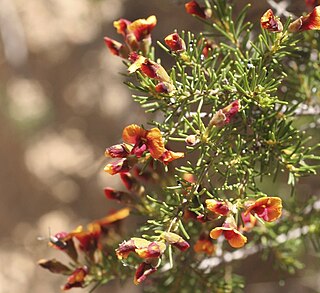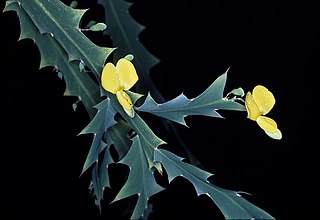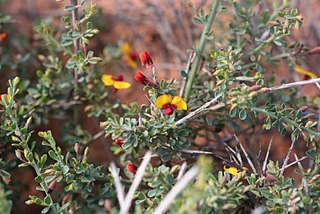
Dillwynia laxiflora is a species of flowering plant in the family Fabaceae and is endemic to Western Australia. It is a prostrate to spreading shrub with needle-shaped leaves and yellow and red flowers.

Bossiaea cordigera , commonly known as wiry bossiaea, is a species of flowering plant in the family Fabaceae and is endemic to southern Australia. It is a straggling shrub with wiry branches, egg-shaped to more or less heart-shaped leaves and yellow and red flowers.

Bossiaea aquifolium , commonly known as water bush, nedik or netic, is a species of flowering plant in the pea family Fabaceae and is endemic to Southwest Australia. It is a slender shrub or small tree with egg-shaped leaves arranged in opposite pairs and yellowish flowers arranged singly or in pairs on the ends of branchlets.
Bossiaea bracteosa, commonly known as mountain leafless bossiaea, is a species of flowering plant in the family Fabaceae and is endemic to north-eastern Victoria, Australia. It is a dense shrub that often forms root suckers and has winged branches, winged and lobed cladodes, leaves reduced to small scales, and deep yellow flowers, often with red blotches.

Petrophile semifurcata is a species of flowering plant in the family Proteaceae and is endemic to an area near the west coast of Western Australia. It is an erect, bushy shrub with sharply-pointed, needle-shaped, sometimes lobed leaves and oval heads of silky-hairy, whitish, lemon-yellow or cream-coloured flowers.

Bossiaea bossiaeoides is a species of flowering plant in the family Fabaceae and is endemic to northern Australia. It is much-branched, glabrous shrub with broadly winged stems, winged and lobed cladodes, leaves reduced to small scales, and yellow flowers, sometimes with orange or red blotches.

Bossiaea rupicola is an erect shrub in the pea family (Fabaceae), which is native to Queensland and New South Wales.

Bossiaea brownii is a species of flowering plant in the family Fabaceae and is endemic to eastern Queensland. It is an erect shrub with egg-shaped leaves and yellow flowers with red markings.
Dillwynia divaricata is a species of flowering plant in the family Fabaceae and is endemic to the south-west of Western Australia. It is an erect, spindly shrub with cylindrical, grooved leaves and yellow flowers with brownish markings.

Pultenaea acerosa, commonly known as bristly bush-pea, is a species of flowering plant in the family Fabaceae and is endemic to south-eastern continental Australia. It is a rigid, much-branched shrub with glabrous, grooved, needle-shaped leaves and yellow flowers with red veins.
Bossiaea arcuata is a species of flowering plant in the family Fabaceae and is endemic to a small area in Western Australia. It is an erect, openly-branched, more or less leafless shrub with often arched cladodes, and yellow and red pea-like flowers.
Bossiaea atrata is a species of flowering plant in the family Fabaceae and is endemic to the south-west of Western Australia. It is a dense, erect, spiny shrub with oblong to elliptic or almost round leaves, and orange-yellow and dark red flowers.
Bossiaea aurantiaca is a species of flowering plant in the family Fabaceae and is endemic to the south-west of Western Australia. It is a rounded or spreading, spiny shrub with oblong to narrow egg-shaped leaves, and golden-yellow and pinkish-red flowers.
Bossiaea barbarae is a species of flowering plant in the family Fabaceae and is endemic to Western Australia. It is an erect, compact, spiny shrub with egg-shaped to elliptic or oblong leaves, and deep yellow and bright red flowers.
Bossiaea barrettiorum is a species of flowering plant in the family Fabaceae and is endemic to a restricted area in the Northern Kimberley region of Western Australia. It is low, spreading or prostrate shrub with winged stems, winged cladodes, leaves reduced to small scales, and deep yellow and red flowers.

Bossiaea calcicola is a species of flowering plant in the family Fabaceae and is endemic to the far west of Western Australia. It is compact, glaucous, spiny shrub with oblong, wedge-shaped or round leaves and bright yellow, reddish and greenish-yellow flowers.
Bossiaea celata is a species of flowering plant in the family Fabaceae and is endemic to Western Australia. It is a compact, many-branched shrub with flattened cladodes, leaves reduced to scales, and yellow to pinkish-red pea-like flowers.

Bossiaea concolor is a species of flowering plant in the family Fabaceae and is endemic to eastern Australia. It is an erect shrub with elliptic to oblong or egg-shaped leaves with the lower end towards the base, and yellow and red flowers.
Bossiaea cucullata is a species of flowering plant in the family Fabaceae and is endemic to Western Australia. It is a dense, many-branched shrub with narrow-winged cladodes, leaves reduced to dark brown scales, and yellow and deep red or pale greenish-yellow flowers.

Bossiaea dentata is a species of flowering plant in the family Fabaceae and is endemic to the south of Western Australia. It is an erect, sometimes prostrate shrub with variably-shaped leaves and greenish-yellow or pink to burgundy-coloured flowers.











